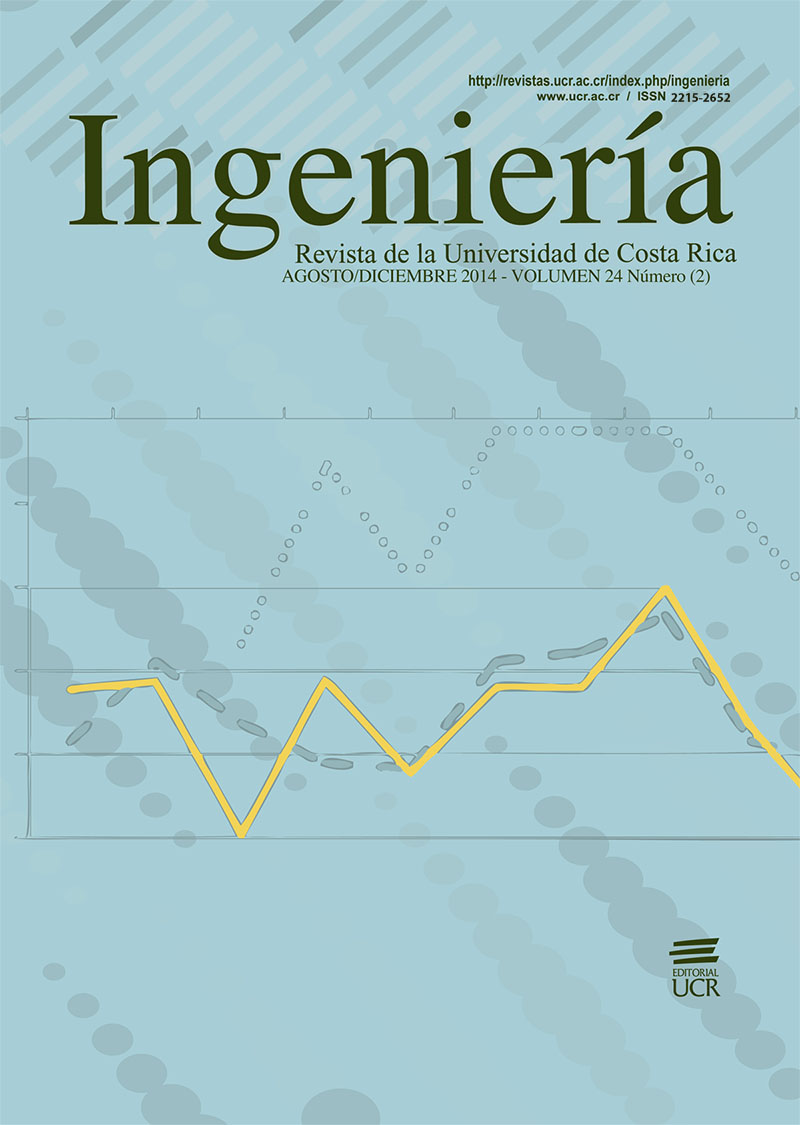Resumen
El siguiente trabajo presenta una revisión de los métodos de simulación molecular más utilizados por científicos, ingenieros e informáticos; de esta manera, se hace una breve descripción del fundamento matemático de cada método. Además, se profundiza en los métodos utilizados para la simulación molecular de la estructura del ADN, los detalles necesarios para su simulación y una reseña de algunas de las herramientas (software) disponibles más actualizadas para la simulación de esta macromolécula y el análisis de resultados.
Citas
Amber. (2013). Amber Home Page. Extraído de la página: http://ambermd.org/, el día 12 de abril de 2013.
Amber. (2000). Example 4: using a truncated octahedral box. Extraído de la página: http://ambermd.org/doc6/html/AMBER-sh-4.4.html, el día 12 de abril de 2013.
Atkins, P., de Paula, J. (2010). Physical chemistry. (9na ed). Nueva York: W.H. Freeman and Company.
Bruice, P. (2008). Química orgánica. 5ta ed. México: Pearson Prentice Hall.
Cotter, G. (2011). Administración de la producción. (2da ed). San Pedro, Costa Rica: Editorial de la Universidad de Costa Rica.
Dans, P., Zeida, A., Machado, M., Pantano, S. (2010). A coarse grained model for Atomic-Detailed DNA simulations with explicit electrostatics. J. Chem. Theory Comp, 6(5), 1711-1725.
Freeman, G., Hinckley, D., de Pablo, J. (2011). A coarse-grain three-site-per-nucleotide model for DNA with explicit ions. J. Chem. Phys, 135, 165104.
Frenkel, D., Smit, B. (2002). Understanding molecular simulation: From Algorithms to Applications. San Diego: Academic Press.
GROMACS. (2013). About Gromacs. Extraído de la página: http://www.gromacs.org/About_Gromacs, el día 12 de abril de 2013.
Guillot, B. (2002). A reappraisal of what we have learnt during three decades of computer simulation on water. Journal of Molecular Liquids, 101(1-3), 219-260.
Hess, B., Kutzner, C., van der Spoel, D., Lindahl, E. (2008). GROMACS 4: Algorithms for Highly Efficient, Load-Balanced, and Scalable Molecular Simulation. Journal of Chemical Theory and Computation, 4(3), 435-447.
Hinckley, D., Freeman, G., Whitmer, J., de Pablo, J. (2013). 3SPN.2: An Experimentally-Informed Coarse-Grained Model of DNA. J. Chem. Phys. En prensa.
Humphrey, W., Dalke, A., Schulten, K. (1996). VMD: Visual molecular dynamics. J. Mol. Graphics, 14(1), 33-38.
Hyeon, C., Thirumalai, D. (2011). Capturing the essence of folding and functions of biomolecules using coarse-grained models. Nature Communications, 2:487, DOI: 10.1038/ncomms1481
Institute of Molecular Engineering (IME). (2013). Researchers review advances in the exploring of quantum computing. Extraído de la página: http://molecularengineering.uchicago.edu/news/advances_in_exploration_of_quantum_computing.shtml, el 8 de abril de 2013.
Jorgensen, W., Jenson, C. (1997). Temperature dependence of TIP3P, SPC, and TIP4P Water from NPT Monte Carlo Simulations: Seeking Temperatures of Maximum Density. Journal of Computational Chemistry, 19(10), 1179-1186.
Knotts, T., Rathore, N., Schwartz, D., de Pablo, J. (2007). A coarse grain model for DNA. J. Chem. Phys., 126, 084901.
Laio, A., Parinello, M. (2002). Escaping free-energy minima. Proc. Natl. Acad. Sci. USA, 99, 12562-12566.
Laio, A., Gervasio, F. (2008). Metadynamics: a method to simulate rare events and reconstruct the free energy in biophysics, chemistry and material science. Reports on Progress in Physics, 71, 126601.
Lavery, R., Moakher, M., Maddocks, J., Petkeviciute, D., Zakrzewska, K. (2009). Conformational analysis of nucleic acids revisited: Curves+. Nucleic Acids Research, 37(17), 5917-5929.
Linak, M., Tourdot, R., Dorfman, K. (2011). Moving beyond Watson-Crick models of coarse grained DNA dynamics. J. Chem. Phys., 135, 205102.
Lu, X., Olson, W. (2003). 3DNA: a software package for the analysis, rebuilding and visualization of three-dimensional nucleic acid structures. Nucleic Acids Research, 31(17), 5108-5121.
Mark, P., Nilsson, L. (2001). Structure and Dynamics of the TIP3P, SPC and SPC/E Water Models of 298 K. J. Phys. Chem., 105, 9954-9960.
Nelson, D., Cox, M. (2008). Lehninger Principles of Biochemistry. (5ta ed). Nueva York: W.H. Freeman and Company.
Ouldridge, T., Louis, A., Doye, J. (2011). Structural, mechanical, and thermodynamic properties of a coarse-grained DNA model. J. Chem. Phys., 134, 085101.
Pérez, A., Marchán, I., Svozil, D., Sponer, J., Cheatham, T., Laughton, C., Orozco, M. (2007). Refinement of the AMBER Force Field for Nucleic Acids: Improving the Description of α/γ Conformers. Biophysical Journal, 92(11), 3817-3829.
Rohs, R., West, S., Sosinsky, A., Liu, P., Mann, R., Honig, B. (2009). The role of DNA shape in protein-DNA recognition. Nature, 461, 1248-1254.
Salomon, R., Case, D., Walker, R. (2012). An overview of the Amber biomolecular simulation package. WIREs Comp. Mol. Sci., doi: 10.1002/wcms.1121.
Sambriski, E., Schwartz, D., de Pablo, J. (2009). A mesoscale model of DNA and its renaturation. Biophysical Journal, 96(5), 1675-1690.
Singh, S., Chopra, M., de Pablo, J. (2012). Density of States-Based Molecular Simulations. Annual Review of Chemical and Biomolecular Engineering, 3, 364-394.
van der Spoel, D., van Maaren, P., Berendsen, H. (1998). A systematic study of water models for molecular simulation: Derivation of water models optimized for use with a reaction field. J. Chem. Phys., 108, 10220.
Wing, R., Drew, H., Takano, T., Broka, C., Tanaka, S., Itakura, K., Dickerson, R. (1980). Crystal structure analysis of a complete turn of B-DNA. Nature., 287 (5784),755-758.
Zielkiewicz, J. (2005). Structural properties of water: Comparison of the SPC, SPCE, TIP4P and TIP5P models of water. J. Chem. Phys., 123, 104501.

